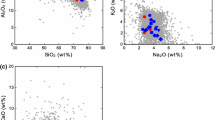Abstract
Experiments specifically devoted to problems of oversaturated peralkaline rocks have been primarily concerned with quartz + feldspar + liquid equilibria, and the determination of the low temperature liquids in the feldspar primary phase region. The results are brought together, and compared with natural compositions, by recalculating and plotting in the system Na2O-K2O-Al2O3-SiO2 (molecular). The minimum zone in the peralkaline quartz-feldspar cotectic is the synthetic analogue of most comendites and many pantellerites. Peralkaline trachytes and trachytic pantellerites appear to be the natural equivalents of synthetic low temperature liquids in the feldspar primary phase region, but the more peralkaline liquids cannot be a simple evolutionary series controlled only by feldspar fractionation. Experiments have yet to reveal the relating process (or processes) for the series pantelleritic trachyte to pantellerite.
Feldspars separating from low temperature synthetic and natural liquids are usually Or35 ±5 i.e. equivalent to the composition range of the thermal minimum between the anorthoclase and sanidine solid solution loops in the alkali feldspar join. Such liquids may therefore be envisaged as the locus of compositions in the peralkaline system that are in equilibrium with alkali feldspar at the minimum in the solid solution series. Such feldspar, when it separates from the vast majority of peralkaline liquids is fractionating K2O and Al2O3, making the residual liquids more peralkaline and more sodic.
Development of the peralkaline condition in natural liquids is commonly ascribed to the « plagioclase effect », but this creates its own dilemma by seeming to be effective only in liquids which are already distinctively alkaline. Furthermore it can only work in a low pressure regime. Examination of the high pressure melting curves of possible mantle minerals shows that acmitic pyroxenes have the lowest melting, in either hydrous or anhydrous conditions, especially at low partial pressures of oxygen. This provides a simple source control by which liquids will either be intrinsically peralkaline (if the melt volume is small) or inherit the potential for low pressure operation of the « plagioclase effect » (most basic magmas).
Alkali transfer is well-attested in solid ⇌ vapour experiments and in natural examples of metasomatic aureoles. The mobility of alkalis (and iron) must figure in any realistic scheme of peralkaline petrogenesis. This points up the need for experiments designed to meet the challenge ofopen system magmatism.
Similar content being viewed by others
Author information
Authors and Affiliations
Rights and permissions
About this article
Cite this article
Bailey, D.K. Experimental petrology relating to oversaturated peralkaline volcanics: A review. Bull Volcanol 38, 637–652 (1974). https://doi.org/10.1007/BF02596901
Received:
Issue Date:
DOI: https://doi.org/10.1007/BF02596901




